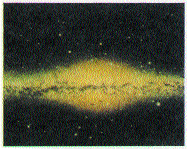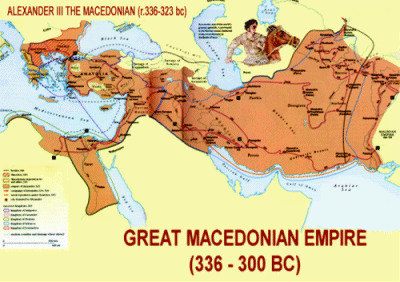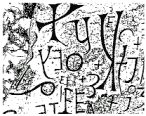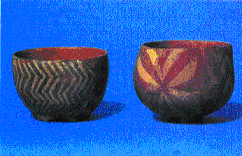Podstawowe pojęcia cywilizacji macedońskiej: „KOSMOS” i „HISTORIA”

Nucleus of the Galaxy Milky Way looked from profile.
Picture by Adolf Schaller
Jądro Drogi Mlecznej tak wygląda z profilu. Zdjęcie: Adolf Schaller
Introductions
Wstęp
For centuries some writers of the history of culture, apart from literacy (whether from ignorance or other reasons) portrayed and are portraying the prehistoric and historical truth of Macedonia as a compriser or influence on a foreign civilisation and the ,Macedonian was treated, or at least they tried through the centuries (and some neighbours are trying even today) to declare him as a citizenwise dead man in other words a (civiliter mortaus), that is as a dead citizen, in other words a citizen of any other former empire or later state who is considered dead even though he is alive and who (in some neighbouring countries even today) has no citizen rights whatsoever.
Such a view in some has produced and still is producing a delusion that allegedly if the Macedonian was once and in some neighbouring countries even today is a dead citizen person, in that case he didn’t do anything and everything found on his ethnic territory and the territory of his present day state – the Republic Macedonia is the result of greater cultures, of the migration of peoples and that means that every thing is an import of a foreign civilisation and foreign civilisation substratums, in other words the Macedonian didn’t have and doesn’t have material evidence of his own authentic culture and literacy about his own state and state order of his own science and education of his own language and his own alphabet, of his symbols and his ethnic identity and so on, in other words of his own authentic civilisation through the past milleniums.
Przez stulecia niektórzy pisarze historii kultury, poza literaturą piękną (czy to z ignorancji, czy z innych powodów), przedstawiali i przedstawiają prehistoryczną i historyczną prawdę o Macedonii jako kompromitującą lub Macedonię jako będącą pod wpływami obcych cywilizacji. Macedończycy byli traktowani lub przynajmniej przez wieki próbowano (a niektórzy sąsiedzi próbują nawet dzisiaj) ogłosićjako nieistniejacych obywateli, innymi słowy (Civiliter mortaus), czyli naród wymarły, innymi słowy Macedończycy są obywatelami jakiegokolwiek innego dawnego imperium, ale nie Macedonii. Później stwierdza się, że Macedończycy uważani są za wymarłych (mimo że żyją) oraz że nie mają żadnych praw by być Macedończykami (w niektórych sąsiednich krajach nawet dzisiaj). Taki pogląd u niektórych wywołał i nadal wywołuje złudzenie, że jeśli Macedończycy rzekomo kiedyś istnieli, to w niektórych sąsiednich krajach nawet dziś są nadal uważani za wymarłych i takich którzy nie zrobili nic w dziejach, a wszystko, co znajduje się na ich terytorium etnicznym i terytorium ich obecnego państwa – Republika Macedonii, jest wynikiem działania większych kultur, migracji ludów, a to oznacza, że wszystko jest importem obcej cywilizacji i obcych substratów cywilizacyjnych. Innymi słowy Macedończycy nie mieli i nie mają żadnych materialnych dowodów na swoją autentyczną kulturę i wiedzę na temat własnego stanu i porządku państwowego, własnej nauki i edukacji, własnego języka i własnego alfabetu, symboli i tożsamości etnicznej itd., innymi słowy nigdy nie mieli własnej autentycznej cywilizacji przez minione tysiąclecia.


THE FISHMAN CABINE AT THE DOJRAN LAKE IS MACEDONIAN PREHISTORIC LAKE SITE SETTLIMENT, WHICH WITH THERE OWN ABORGINAL ARHITECTONIC FORMS, EXIST AT LEAST 8000 – 9000 YEARS.
Sadyba rybacka nad macedońskim jeziorem Dojran w prehistorycznej osadzie, która istnieje we własnych formach budowlanych od co najmniej 8000 – 9000 lat.
According to the many years of painstaking researching, it could be concluded that these Balkan spaces the Macedonians did not steale from nowhere, but they are instead aborigines at least from the period of the matriarch, that is from the time of the great Macedonian mythological empire on three continents; the Macedonians are the oldest people with their own language and their own sound (phonetic) alphabet with a specific but variable social order through the millenniums with a rich four generation old mythology which from monotheism and polytheism (chaos, uran geae with the titans and titanesses, cyclopes and hundred handedones), kron – rhea with the sons Zeus – ruler of the world, Poseidon – ruler of the seas and Hades – ruler of the underworld, so the daughters: Hestia, Demetra and Hera, that is the almighty mischievous 12 olimpic gods among which Macedon too, the eponym of Macedonia and with whom inviolably rules Zeus who sees everything, knows every thing and can do everything and he is helped by his sister and wife Hera, later on turns into a monotheistic religion (Zeus – Maria and their son Jesus Christ, that is the son of god „sos krstot” (with the cross)) with a science which was made up of „higher” and „lower” sciences, with a graded system of education with it own oldest prehistoric rulers who were named zets (son – in – laws) and who with the oldest prehistoric form of ruling who had the zeting (son – in – lawing) and after that in the developed dynastic period that is in the IVth cent B.C. as a narrower form of the united kingdom of upper and lower Macedonia created, that is renewed a historic empire across three continents 3.8 million square kilometres big which in the later historic period via the roman, byzantine, turkish empire left its own noticeable influence unto the development of culture and humanity.
Z wieloletnich żmudnych badań można wywnioskować, że na tych bałkańskich przestrzeniach Macedończycy nie byli najeźdźcami znikąd, ale są raczej tubylcami przynajmniej z okresu matriarchatu, czyli od czasów wielkiego imperium mitologicznego Macedonii na trzech kontynentach. Macedończycy są najstarszym ludem z własnym językiem i własnym alfabetem dźwiękowym (fonetycznym) o specyficznym, ale zmiennym porządku społecznym na przestrzeni tysiącleci, z bogatą cztero-generacyjną mitologią, która od monoteizmu i politeizmu (Chaos, Uran, Gea, z Tytanami i Tytanidami, Cyklopi i Sturęcy, Kronos – Rea z synami, Zeus – władca świata, Posejdon – władca mórz i Hades – władca podziemi, i córki: Hestia, Demeter i Hera, czyli wszechmocna złośliwa 12 bogów olimpijskich, wśród których również Macedon, eponim Macedonii, z którym nienaruszalnie rządzi Zeus, który wszystko widzi, wszystko wie i może wszystko, a pomaga mu siostra i żona Hera), później przekształca się w religię monoteistyczną (gdzie Zeus – Maria i ich syn Jezus Chrystus, czyli syn boga „sos krstot” (z krzyżem)) z nauką złożoną z nauk „wyższych” i „niższych”, ze stopniowanym systemem edukacji z własnymi najstarszymi prehistorycznymi władcami, których nazywano zetami (zięciami) i którzy z najstarszą prehistoryczną formą panowania mieli zięciować, a potem w rozwiniętym okresie dynastii, czyli w IV wieku p.n.e. jako węższa forma stworzonego zjednoczonego królestwa górnej i dolnej Macedonii, czyli odnowione historyczne imperium na trzech kontynentach o powierzchni 3,8 miliona kilometrów kwadratowych, które w późniejszym okresie historycznym poprzez rzymskie, bizantyjskie, tureckie imperium pozostawiło swój znaczący wpływ na rozwój kultury i cywilizacji ludzkości.

ZET KUZO HERUZI
(7000-6000 B.C.)

ZET STOLE N’D’MSEJ
(7000-5000 B.C.)

UTIIK
(1385 B.C.)

IG’L AL
(1385 B.C.)

Z’T T’RPE OD ORESHT
(5000-4500 B.C.)
![]()
Z’T T’GIL T’FIL (Z’T TEGIL TEFIL)
(2100-1500 B.C.)
AUTHENTIC WRITINGS OF NAMES AND SURNAMES OF ANCIENT MACEDONIANS „ZETIANS” (SON`S – IN – LOW) WHO „ZETING” (SON – IN – LOWING) IN A PERIOD FROM 7000 TO 1385 B.C.
AUTENTYCZNE ZAPISY IMION I NAZWISK STAROŻYTNYCH MACEDOŃCZYKÓW i „ZETÓW” (tzw plemię Zetów, mieszkańcy Zety i okolic, związani braterstwem, jako Zięciowie), ZETÓW STAROŻYTNYCH W OKRESIE OD 7000 DO 1385 R.
With the newest research and especially with the latest on the terrain of the surroundings of the village Osinchani performed in 1994 with the preliminary research of an adequate architectural documenting and photo documenting on many prehistorical findings (temples, dolmens, above the grave monuments, separate cliffs and stones with engravings and Solar and cosmographic symbols, ceramic seals and clay tablets with solar symbols, cosmography and various writings etc.) and especially with palaeographic and paleolinguistic research in the period 1992 – 1997 on the soil of Macedonia and wider comes across one uptill now unnoticed authentic civilisation with a Macedonian language, ancient Macedonian sound alphabet with a specific Macedonian „zetian” (son – in – law) zeting (son – in – lawing) as the oldest shape of ruling the world, with a widely dispersed cult of the sun and cosmos (universum) etc. Separately impressive is the fact that we succeeded to register two prehistoric Macedonian phonetic alphabets of which one was intended for public and the other probably for secret (mythological – religious) use.
Dzięki najnowszym badaniom, a zwłaszcza najnowszym na temat terenu okolic wioski Osinchani wykonanych w 1994 roku, wraz ze wstępnymi badaniami odpowiedniej dokumentacji architektonicznej i fotograficznej wielu znalezisk prehistorycznych (świątynie, dolmeny, pomniki nad grobami, oddzielne klify) i kamienie z rycinami i symbolami słonecznymi i kosmograficznymi, pieczęcie ceramiczne i gliniane tabliczki z symbolami słonecznymi, kosmografia i różne napisy itp.), a zwłaszcza z badaniami paleograficznymi i paleolingwistycznymi w latach 1992-1997 na ziemiach Macedonii i szerzej, obecnie niezauważana autentyczna cywilizacja z językiem macedońskim, starożytny macedoński alfabet dźwiękowy z specyficznym macedońskim pojęciem „zetian” (zięć) i „zięcieniem” jako najstarszą formą panowania nad światem, z szeroko rozproszonym kultem słońca i kosmosem (universum) itp. Osobno imponujący jest fakt, że udało nam się zarejestrować dwa prehistoryczne macedońskie alfabety fonetyczne, z których jeden był przeznaczony do użytku publicznego, a drugi prawdopodobnie do użytku tajnego (mitologiczno – religijnego).
Fundamental notions of the macedonian civilization: „KOSMOS” and „HISTORY”
Podstawowe pojęcia cywilizacji macedońskiej: „KOSMOS” i „HISTORIA”

Nucleus of the Galaxy Milky Way looked from profile.
Picture by Adolf Schaller
Jądro Drogi Mlecznej tak wygląda z profilu. Zdjęcie: Adolf Schaller
The Macedonian people and Macedonian science that is Macedonian civilisation, apart from the oldest phonetic alphabet and many other achievements have given the world two fundamental notions: cosmos and history. Namely these notions the helenes as loanwords took from the Macedonians and used them and use them saying that they are from their own lingual production, but without offering an adequate etymology. What in fact do the nouns cosmos and history mean? In the ancient Macedonian language the base of the noun cosmos is formed from the adjective KOS (winding slanted) and the noun MOS (bridge) and it means „kosmos” that is a winding bridge and that’s what the ancient macedonian astronomers called the flock of stars from the milky way, in this way the folck which seen from the earth has a winding line in the shape of a slanted bidge (kosmos) or with this noun they expressed the fourth dimension of our galaxy or cosmic space, just as modern astronomers named the globular flocks of the spiral galaxy NGC 4594 as the galaxy sombrero M1O4 because with their form those globular flocks resembled the spanish or latin american Sombrero. As far as the fundamental word „history” is concerned, it’s root is found in the ancient Macedonian noun „TR” which is the oldest form of the name of the god of thunder. With the appearance– of the first innovations in prehistory or with the start of the functioning of the basic sound law that is the law of the opening of the syllables the following forms were derived: „TOR”, „TOOR”, „TUR”, „TUUR”, „TAR”, „TARA” etc. from the noun „TOR” the imperfect verb was formed „TORI” and from it with the help of the prefixes „S” and „IS” the perfect verb form „STORI” or „ISTORI” was formed so according to the fact that all our ancestors „HISTORY” in the Vth cent B.C. the ionoan Herodot or Irodot (484-424 B.C.) published his writings under the headline with the noun „HISTORY” and in that way he is considered that he put down the foundations to the science called History, even though much older histories than his exist. If the Helenes (Greeks) would like to publish and say with their own noun the past happenings of theirs and others ancestors then they would have to produce a noun of their own from their appropriate verb „KANO”(ka¢nw)>”EKANA” (²ekanan) and name the works of their ancestors with the noun „EKANAN”
Macedończycy i macedońska nauka, to jest cywilizacja macedońska, która oprócz najstarszego alfabetu fonetycznego i wielu innych osiągnięć dała światu dwa podstawowe pojęcia: „kosmos” i „historia”. Są to mianowicie pojęcia, które Helenowie jako zapożyczenia wzięli od Macedończyków i używali ich, mówiąc, że pochodzą z ich własnego obszaru języka, ale nie posiadali ich odpowiedniej etymologii.
Co właściwie oznaczają rzeczowniki kosmos i historia? W starożytnym języku macedońskim podstawa rzeczownika kosmos jest utworzona z przymiotnika KOS (skośny kręty) i rzeczownika MOS (most) i oznacza „kosmos”, czyli kręty most i tak właśnie starożytni macedońscy astronomowie nazywali stado gwiazd z Drogi Mlecznej, w ten sposób ludzie, którzy widzą z Ziemi, mają krętą linię w kształcie skośnego grzbietu (kosmos), lub tym rzeczownikiem wyrażają czwarty wymiar naszej galaktyki lub kosmicznej przestrzeni, tak jak współcześni astronomowie nazywają stada kuliste galaktyki spiralnej NGC 4594 jako galaktykę sombrero M1O4, ponieważ swoją formą te stada kuliste przypominały hiszpańskie lub latynoamerykańskie Sombrero.
Jeśli chodzi o podstawowy rdzeń słowa „historia”, jego korzeń znajduje się w starożytnym macedońskim rzeczowniku „TR”, który jest najstarszą formą imienia boga piorunów. Wraz z pojawieniem się – pierwszych innowacji w prehistorii lub wraz z rozpoczęciem funkcjonowania podstawowego prawa dźwięku, jakim jest prawo otwarcia sylab, wyprowadzono następujące formy: „TOR”, „TOOR”, „TUR” , „TUUR”, „TAR”, „TARA” itd. Od rzeczownika „TOR” uformowano czasownik niedoskonały „TORI” i z niego za pomocą przedrostków „S” i „IS” powstała doskonała forma czasownika „STORI” „lub” ISTORI” tak, że wszyscy nasi przodkowie używali pojęcia „HISTORII”. W V wieku p.n.e. Jończyk Herodot lub Irodot (484-424 p.n.e.) publikował swoje pisma pod tytułem w którym używał rzeczownika „HISTORIA” i ponieważ on zapisał to w ten sposób, uważa się, że położył podwaliny pod naukę zwaną „Historią”, mimo że historie znacznie starsze niż jego oczywiście istnieją. Jeśli Helenowie (Grecy) chcieliby opublikować i nazwać własnym rzeczownikiem przeszłe wydarzenia swoich i innych przodków, musieliby stworzyć własny rzeczownik z odpowiedniego czasownika „KANO” (ka ¢ nw)> „EKANA „(²ekanan) i nazwać dzieła o ich przodkach rzeczownikiem„ EKANAN ”

Irodot or Herodot (484 – 424 b.c.) from Halikarnas, named “Father of history” by Ciceron (106 – 43 b.c.)
Irodot lub Herodot (484 – 424 p.n.e.) z Halikarnas, nazwany „Ojcem historii” przez Cicerona (106 – 43 p.n.e.)
(²ekanan) because the equivalent to the ancient macedonian syntagm „TIE ISTORIA” (they did) is the hellenic syntagm „AVTI EKANAN”(au¢th¢ ekanan).Following this, that which the MACEDONIANS call „ISTORIA” the Helenes should call „EKANAN” (²ekanan)
(²ekanan), ponieważ odpowiednikiem starożytnej macedońskiej syntagmy „TIE ISTORIA” (tak zrobili) jest helleńska syntagma „AVTI EKANAN” (au ¢ th ¢ ekanan). „EKANAN” (²ekanan)
With the newest deciphering on many inscriptions, writings or texts from the end of the Mesolithic and the start of the Neolithic right upto the second period of the Ironage (Iron II) that is from 7.000 – 6.000 B.C. till the VIIth – VIth cent B.C. it is possible to fill in many empty spaces in the ancient history of the macedonian people and their social formation from the time of the matriarch and early patriarch and the obtained linguistic information from the field of the syntactic, semantic and utilised value of the language treated as a system of connected signs with an already before hand, differentiated and developed system of graphemes and phonemes enabling us to overcome some misleading, understatements or wrong views in science in relation to the problems of the so called written signs of the Neolithic cultures that is in the era of the functioning of the sound (phonetic) alphabet which enables us deciphering and acquitenance with the haltered and fixated articulated speech of our ancestors.
Dzięki najnowszemu rozszyfrowaniu wielu inskrypcji, pism lub tekstów od końca mezolitu i początku neolitu aż do drugiego okresu epoki Żelaza (żelazo II), czyli od 7.000 – 6.000 p.n.e. do VII – VI wieku p.n.e. można wypełnić wiele pustych miejsc w starożytnej historii narodu macedońskiego i jego formacji społecznej od czasów matriarchatu i wczesnego patriarchatu oraz uzyskanych informacji językowych z zakresu składniowej, semantycznej i użytkowej wartości języka jako systemu połączonych znaków z już istniejącym, zróżnicowanym i rozwiniętym systemem grafemów i fonemów, umożliwiającym przezwyciężenie pewnych wprowadzających w błąd, niedomówień lub błędnych poglądów w nauce w odniesieniu do problematyki tzw. znaków pisanych kultur neolitycznych, czyli w dobie funkcjonowania alfabetu dźwiękowego (fonetycznego), który pozwala nam rozszyfrować i oswoić się z usztywnioną i utrwaloną mową powiązaną naszych przodków.

Inscriptions from the ancient settlement “Barutnica”
near Anzabegovo (7000 – 6000 years b.c.)
Napisy ze starożytnej osady „Barutnica” niedaleko Anzabegovo (7000 – 6000 lat p.n.e.)

Half – spherical plates, ancient settltment “Barutnica, Anzabegovo, early neolithic (7000 – 6000 years b.c.)
Misy półkuliste, starożytna osada „Barutnica, Anzabegovo, wczesny neolit (7000 – 6000 lat pne)
Today already we are in the position to differentiate and present a relatively rich pre – historic linguistic material from which it is possible to separate the phonology, the linguistic units, their constituent relations, their syntactic relations, the means of those relations, the grammatical semantics of separate linguistic units etc that is concrete peculiarities of the oldest developing phase of the macedonian language fixated and preserved in authentic form on various pre – historic inscriptions which serve as a document, as a living witness and in the most direct way perform an identification on the autochthony of the pre – historic population of Macedonia and on a wider scale the Balkan – Anadolian cultural complex
